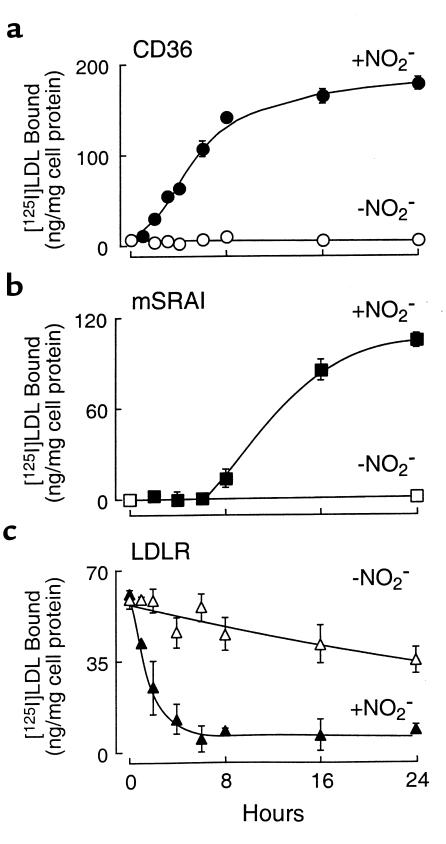Figure 4.
Time dependence of LDL-ligand properties after exposure to the MPO-H2O2-NO2– system. [125I]LDL (0.2 mg/mL) was incubated with isolated human MPO (30 nM), glucose (100 μM), and glucose oxidase (20 ng/mL) in sodium phosphate buffer (50 mM, pH 7.0) supplemented with DTPA (100 μM) for the indicated times in either the presence (+ NO2–, filled symbols) or absence (– NO2–, open symbols) of NO2– as described in Methods. Binding of the modified lipoprotein by (a) CD36-transfected 293 cells; (b) mSRA-I–expressing CHO cells, and (c) human foreskin fibroblasts was then determined as described in Methods. Note that the time course for the acquisition of scavenger receptor CD36 recognition and loss of LDLR recognition are early events during lipoprotein modification, whereas acquisition of mSR-AI recognition requires more prolonged lipoprotein oxidation. Data represent the mean ± SD for triplicate determinations of a representative experiment performed at least 3 times. The REM of lipoprotein preparations exposed to the MPO-H2O2-NO2– system for 0, 1, 2, 4, 8, 16, and 24 hours were 1.0, 1.02, 1.13, 1.26, 1.44, 2.01, and 2.22, respectively. The lysine content (percent of control) of LDL exposed to the MPO-H2O2-NO2– system for 0, 1, 2, 4, 8, 16, and 24 hours was 100, 93.4, 90.3, 86.4, 83.7, 75.9, and 68.8, respectively.

